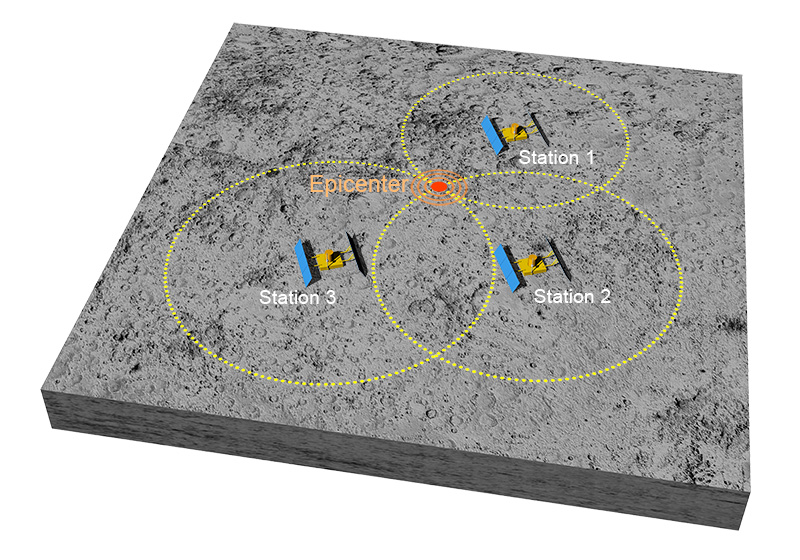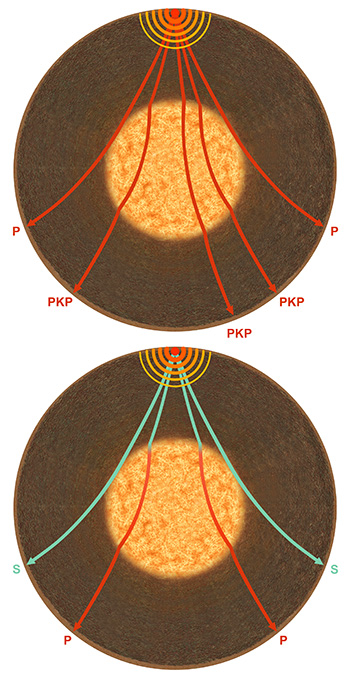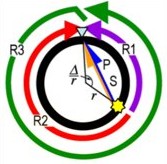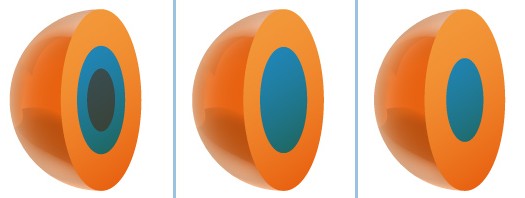Seismic investigation of Mars
Can seismic activity be studied with a single seismometer?
By definition, seismology is a science that depends on networks. Earth is currently covered by a grid of over 20,000 seismometers that form a gigantic web around the globe and allow an earthquake to be located and characterised almost instantly, regardless of its size and origin. Massively interconnected, this network gives scientists direct access to data and considerably facilitates interaction between geophysicists around the world.
Some of the great seismological discoveries have been made with a small number of stations. The discovery of the Earth’s metallic core by Oldham in 1906 needed only 14 earthquakes, whose tremors were intercepted by a few dozen listening stations. However, the installation of a network of stations is imperative in seismology. For example, one of the basic rules stipulates that, in order to locate the depth and epicentre of a quake, at least three seismometers are required for triangulation.
 Principle of triangulation to locate the epicenter of an earthquake (© IPGP / David Ducros).
Principle of triangulation to locate the epicenter of an earthquake (© IPGP / David Ducros).
Hence, the first planetary seismological projects on the Moon or Mars required network of stations to be set up. Instruments placed on the Moon during the Apollo missions gave geophysicists a mini network of five stations: four seismometers placed during the Apollo 12, Apollo 14, Apollo 15 and Apollo 16 missions, plus the gravimeter on Apollo 17). After the Moon, the first attempt to probe the centre of Mars was in 1976 with the Viking mission. The seismological experiment depended on two seismometers, one for each lander, but gave no useful results.
The post-Viking Martian projects were particularly ambitious with regard to the number of stations to be landed: MESUR consisted of 16 seismometers, and Netlander was planned to land another four. In 1996, Mars 96 took off with two seismometers on board, but failed to leave Earth orbit. The fact that the InSight lander is flying only one seismometer perfectly demonstrates the gulf that separates the desires of scientists, who want to deploy the greatest possible number of seismometers, and the stern limits of reality.
Seismology using a single station
 Detection of the core by direct propagation of seismic waves. Note that on the bottom illustration, S waves convert into P waves for the liquid external core. (© rights reserved).
Detection of the core by direct propagation of seismic waves. Note that on the bottom illustration, S waves convert into P waves for the liquid external core. (© rights reserved).
Despite the fact that SEIS is an ultra-sensitive gem of technology that can measure ground displacements smaller than the diameter of an atom, it is legitimate to wonder about the instrument’s limitations, given that it is on its own on the surface of Mars.
Operating on its own, without the help of any companions, can SEIS really significantly advance our understanding of the depths of Mars and the processes going on in its interior?
Astonishing as it may seem, the scientists and engineers behind SEIS have done all that they can to gather a maximum of data. Thanks to several clever tricks that take advantage of the special features of Mars as well as sophisticated signal processing techniques, most of the limitations inherent in operating solo, without a network, will be addressed.
Seismic activity
As we saw previously, Mars appears to be a celestial body with little promise for seismic study. On Earth, the vast majority of quakes are related to plate tectonics. However, this phenomenon is absent on Mars, so we can expect the planet to be affected by seismic activity roughly 100 times weaker than that on Earth. Consequently, marsquakes will be less intense and far less numerous than earthquakes. To pierce the secrets of Mars’ interior, the ideal would be to make use of a multitude of quakes releasing a large amount of energy.
Optimistically, geophysicists expect to be able to observe a few quakes of magnitude 5 or 6 over the course of one year on Mars (equivalent to two years on Earth), whereas Earth has roughly 1,500 seismic events of magnitude 5 per Earth year.
On the other hand, Mars is much quieter than Earth: there is neither human activity nor the noise of pounding ocean waves on Mars. Atmospheric circulation can obviously pose problems, but given the absence of vegetation, there are no trees to transmit the sound of the wind down into the ground. This silence is a real boon when it comes to listening to tremors of feeble intensity, provided, of course, that the available instrument is sufficiently sensitive, which is the case of SEIS.
Location and magnitude of a quake
Let us assume that a quake occurs and that we wish to locate it on Mars with the only station there is on the surface, SEIS. How do we go about it?
The distance between the epicentre, i.e. the point on the surface immediately above the zone from which the tremor originated (known as the hypocentre) and the receiving station (i.e. InSight), can easily be calculated by measuring the difference between the arrival time of the P-waves (which arrive first at the seismometer) and the arrival time of the S-waves (which arrive second). The error here is only about 10%.
To locate the epicentre, we need to determine not only the tremor’s distance from the station but also its direction, i.e. its “azimuth”. The direction from which the seismic waves arrive can be determined due to the fact that SEIS measures seismic signals in all three spatial directions. Using the horizontal plane data provided by the seismometer’s pendulums, direction can be calculated to within 10°.
Finally, the magnitude of the tremor—a measurement of the amount of energy released—can be calculated by measuring the amplitude of ground displacements, taking into account the distance between the source of the quake and the seismometer, knowing that whether the seismic waves travel through the interior of the planet or around the surface, they will always be attenuated.
Even though it will be difficult to locate small quakes, SEIS will nevertheless provide data that will enable a tremor to be related to a particular region of Mars and hence be correlated with the geological structures that are visible on the surface (e.g. faults or volcanoes), as well as larger-scale geophysical features.
A quick trip around Mars before disappearing
In order to locate quite large tremors, InSight has other tricks up its sleeve. The diameter of Mars is half that of the Earth, which is advantageous when observing quakes. Since its circumference is smaller, seismic waves have less far to travel from the point of origin (i.e. the hypocentre) to the receiver. With shorter propagation distances, the attenuation is reduced since less energy is lost.
 Circulation of surface (Rayleigh) waves R1, R2 and R3 (© rights reserved).If the tremor has sufficient energy (greater than magnitude 4.5), the surface waves can even pass the InSight landing site several times before finally vanishing due to attenuation. On Earth, quakes of magnitude at least 6 are necessary for such a phenomenon to be observable, i.e. a difference of roughly an order of magnitude. In other words, a quake on Earth must release more than 40 times as much energy than on Mars to be able to generate surface waves capable of travelling the whole way around the planet once.
Circulation of surface (Rayleigh) waves R1, R2 and R3 (© rights reserved).If the tremor has sufficient energy (greater than magnitude 4.5), the surface waves can even pass the InSight landing site several times before finally vanishing due to attenuation. On Earth, quakes of magnitude at least 6 are necessary for such a phenomenon to be observable, i.e. a difference of roughly an order of magnitude. In other words, a quake on Earth must release more than 40 times as much energy than on Mars to be able to generate surface waves capable of travelling the whole way around the planet once.
The illustration above shows the propagation of surface waves for a marsquake. The surface waves that travel from the quake towards the InSight lander, and which are the first to reach the seismometer, are known as R1. The waves that travel in the opposite direction around the planet, and which have a greater distance to cover before reaching the lander, arrive second; these are known as R2. Finally, if the quake has sufficient energy (not less than magnitude 4.5), then the R1 waves—after having once passed the station—are capable of travelling all the way around the planet once more, thus passing the lander for the second time. These are the R3 waves.
In such a scenario, the distance separating InSight from the source of the quake, its time of origin, and the average speed at which the waves propagate over the planet’s surface, can be estimated by combining the arrival times of the R1, R2 and R3 waves. As before, the azimuth (the direction of the quake) is estimated from the signals recorded by the seismometer’s horizontal sensors. Quakes of magnitude 4.5 or greater are relatively rare on Mars, but geophysicists believe that over the duration of the mission (one Mars year, i.e. two Earth years), it should be possible to observe between 3 and 5 such events.
It is important to note that the effectiveness of the techniques to be used for InSight have been validated on Earth with data from single stations. These have been able to reconstruct the Preliminary reference Earth model (PREM), a model of the Earth’s internal structure commonly used by geophysicists with acceptable error bars.
There are unknowns, however, and the validity of the technique summarised above can be confirmed only when InSight lands on Mars. The Red Planet may also have a few small surprises in store for us. On the Moon, geophysicists were astonished to discover that the lunar crust caused enormous diffraction of the seismic waves, preventing the existence of surface waves. Since the Martian crust, just like the lunar crust, was exposed to a massive bombardment of asteroids early on in the formation of the solar system, its pulverised nature and numerous craters, especially in the planet’s southern hemisphere, could also cause seismic waves to be diffracted; seriously complicating analysis. Fortunately, however, the effect is smaller at the low frequencies to which very broad band seismometers such as SEIS are sensitive.
The origin of marsquakes
 Three possible scenarios as to the geographical location of marsquakes: from left to right, uniform distribution over the Martian globe; clustering in the volcanic provinces of Tharsis and Elysium; or a non-uniform distribution (©rights reserved).
Three possible scenarios as to the geographical location of marsquakes: from left to right, uniform distribution over the Martian globe; clustering in the volcanic provinces of Tharsis and Elysium; or a non-uniform distribution (©rights reserved).
Apart from the quakes per se, other sources of seismic wave can come to the aid of the SEIS seismometer in its quest to investigate the depths of the Red Planet. Whether on Earth or Mars, these planets are still exposed to a hail of meteorites, mostly from the asteroid belt. A study of the high-resolution images of the Martian surface provided by Mars Global Surveyor and, more recently, Mars Reconnaissance Orbiter, has identified several very recent impact craters caused by meteorites of various sizes. With a little luck, a few impacts will generate a seismic wavefront sufficiently powerful to shed light on the planet’s interior.
It is also possible, though unlikely, that volcanic events can give rise to seismic activity. Although certain regions of Mars were volcanically active a mere 10 million years ago, no eruption or hydrothermal event has ever been detected on the surface. However, it is possible that there is still some magmatic activity, with magma continuing to shift through subterranean tunnels or chambers.
As we shall see in due course, the continual circulation of the atmosphere around the globe causes it to resonate. While this seismic “hum,” as it is known by geophysicists, is very subtle, it is perfectly audible to instruments sensitive to very low frequencies, like SEIS. The study of these eigenmodes (see below) will offer very promising possibilities in the investigation of Mars’ mantle.
As it orbits the Sun, Mars is accompanied by two small moons, Phobos and Deimos. Although much smaller than our Moon, they are nonetheless bound gravitationally to Mars and exert a (rather weak) force of attraction on it. Phobos, the largest natural satellite and the nearest to Mars, causes deformations in the ground that can be measured by SEIS. A study of these tides, whose forces are here exerted not on expanses of water but on rock, could provide critical information about Mars’ core.
To conclude this overview of the phenomena that InSight can exploit to achieve its mission, we note the interactions between the surface and the atmosphere. The action of the wind at the landing site will generate micro-seismic noise that will contaminate the signals collected by the seismometer, but ever-resourceful geophysicists can even make use of this to probe the first few hundred metres below the surface.
Finally, although SEIS is by nature a passive experiment, i.e. the seismic waves needed to study the depths of Mars are generated by natural phenomena without any human intervention, active measurements will nonetheless be taken when the drill attached to the HP3 instrument starts to penetrate the ground. The tremors generated by the staccato advance of the penetrator could actually help SEIS determine what lies hidden close to the lander’s feet.
Of course, these active measurements will not be in the same league as those made on Earth using vibrating trucks on the ground or seismic air guns in the sea. Neither can they be compared with those taken on the Moon during the controlled crash of rocket stages or lunar modules. However, in the world of space science nothing is wasted, and scientists seize the slightest opportunity for any additional. This is why the vibrations generated by the HP3 heat flow package will play a small but not insignificant role in determining the structure of the Red Planet’s surface.
Investigating the crust: dispersion of surface waves and receiver function
One of InSight’s major objectives is to measure the thickness of the Martian crust and identify the presence of discontinuities, i.e. the existence of layers that are different in terms of composition and structure (lava strata, frozen water, etc.) that will influence the propagation speed of seismic waves.
Geophysicists have several tools at their disposal to meet this objective. A study of the reflection of seismic waves within the crust will be particularly useful, as will techniques involving analysis of the dispersion of surface waves or “receiver function” techniques.
The surface wave dispersion technique is quite a powerful analysis tool for probing a planet’s crust. When a seismic wave packet travels through the crust after a quake, the low-frequency waves travel faster and are able to sample greater depths. Conversely, higher-frequency waves travel more slowly, and tend to remain slightly more grouped on the surface.
By analysing this variation in wave propagation speed as a function of frequency (called “dispersion”), geophysicists can obtain a great deal of significant information about the rocky surface structure of a planet’s crust, and even the underlying mantle if the low frequencies can be measured. This technique is particularly sensitive to changes in thickness, so a variation of just 10% in the crust’s thickness causes changes of 5% in the group velocity.
The “receiver function” technique is used to improve the signal-to-noise ratio by studying the echoes in the seismic signals. This entails in particular identifying those waves that have undergone a conversion (e.g. conversion of a P-wave into an S-wave) when passing through an interface. These generally less energetic waves require the signals to be summed so that they can emerge from the background noise and become visible.
Meteorite impacts and surface deformation caused by atmospheric disturbances will also provide important information about the Martian crust.
Investigating the mantle
The Martian mantle, especially the upper mantle down to about 600 km, will be probed using bulk seismic waves capable of traversing the planet (i.e. P- and S-waves). The surface wave dispersion analysis technique mentioned above could also prove to be useful.
The slow natural oscillations of Mars that geophysicists call eigenmodes will also be used to advantage. Like Earth, Mars can resonate like a bell if excited by a major quake or, more subtly, by the continuous circulation of the atmosphere. Geophysicists can use eigenmodes to tease out a whole mass of relevant information about the structure and composition of the mantle. One of the great advantages of eigenmodes is that no knowledge of the location of the source of seismic waves is necessary. However, only very wide band instruments such as the SEIS seismometer are capable of perceiving the very low-frequency hum associated with eigenmodes.
Quakes capable of exciting Mars’ eigenmodes and causing the planet to resonate are relatively rare. They must be of at least magnitude 5.5. From the beginning to the end of the InSight mission, only one or two tremors of this type can be expected. The advantage here is that the energy transmitted to the planet will be big enough to distinguish the oscillations from the instrument’s noise floor.
Unlike major quakes, the excitation of eigenmodes due to atmospheric turbulence is continuous over time. However, in terms of energy content, this excitation lies below the limit of detection of the SEIS seismometer. Hence it will be necessary to accumulate data over several months of observation to benefit from atmospheric excitation and see through the window that this very subtle phenomenon opens up into the depths of the Red Planet.
Investigating the core
 Three models of the Martian core (© rights reserved).
Three models of the Martian core (© rights reserved).
Although deep down in the centre of the planet, Mars’ core is nevertheless within reach of InSight’s SEIS instrument.
It can be studied by monitoring the seismic waves (i.e. bulk waves) that propagate within the planet and are reflected off the surface of the core like a mirror before travelling upwards.
A detailed study of the rotation of Mars by the RISE geodesy experiment will also be able to tell whether the core is in a liquid or solid state, and to estimate its size. The tides of the Phobos moon should provide confirmation of these two aspects.
Last updated : 27 february 2018





